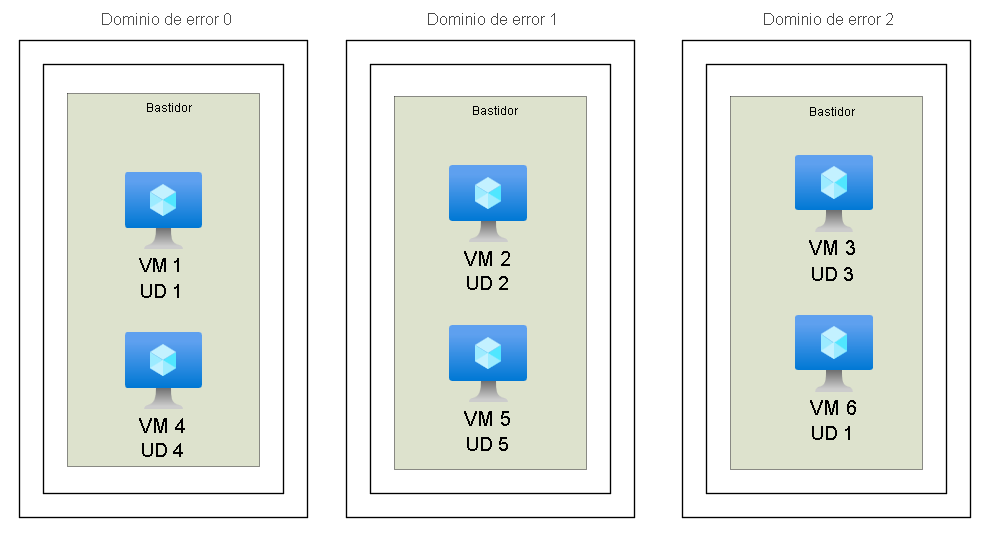Nota
El acceso a esta página requiere autorización. Puede intentar iniciar sesión o cambiar directorios.
El acceso a esta página requiere autorización. Puede intentar cambiar los directorios.
Se aplica a: ✔️ Máquinas virtuales Linux ✔️ Máquinas virtuales Windows
En este artículo se proporciona información general sobre las características de disponibilidad de las máquinas virtuales (VM) de Azure.
Nota:
Se recomienda que los clientes elijan Conjuntos de escalado de máquinas virtuales con el modo de orquestación flexible para lograr una alta disponibilidad con la gama más amplia de características. Virtual Machine Scale Sets:
- Permitir que las instancias de máquina virtual se administren, configuren y actualicen centralmente.
- Aumente o reduzca automáticamente el número de instancias de máquina virtual en respuesta a la demanda o a una programación definida.
Los conjuntos de disponibilidad solo ofrecen alta disponibilidad.
¿Qué es un conjunto de disponibilidad?
Los conjuntos de disponibilidad son agrupaciones lógicas de máquinas virtuales que reducen la posibilidad de errores correlacionados que reducen las máquinas virtuales relacionadas al mismo tiempo. Los conjuntos de disponibilidad colocan máquinas virtuales en distintos dominios de error para mejorar la confiabilidad. Esta acción es especialmente beneficiosa si una región no admite zonas de disponibilidad.
Al usar conjuntos de disponibilidad, cree dos o más máquinas virtuales dentro de un conjunto de disponibilidad. El uso de dos o más máquinas virtuales en un conjunto de disponibilidad ayuda a mantener las aplicaciones de alta disponibilidad y cumple el acuerdo de nivel de servicio (SLA) de Azure del 99,95 %. No hay ningún costo adicional para usar conjuntos de disponibilidad. Solo se paga por cada instancia de máquina virtual creada.
Los conjuntos de disponibilidad ofrecen latencias mejoradas de máquina virtual a máquina virtual en comparación con las zonas de disponibilidad, ya que las máquinas virtuales de un conjunto de disponibilidad se asignan en proximidad más cercana. Los conjuntos de disponibilidad tienen aislamiento de errores para muchos posibles errores, para minimizar los puntos únicos de error y ofrecer alta disponibilidad. Los conjuntos de disponibilidad siguen siendo susceptibles a determinados errores de infraestructura compartida, como los errores de red del centro de datos, que pueden afectar a varios dominios de error.
Para obtener más confiabilidad que la que ofrecen los conjuntos de disponibilidad, use zonas de disponibilidad. Las zonas de disponibilidad tienen la mayor confiabilidad. Cada máquina virtual se implementa en varios centros de datos para ayudarle a protegerse de la pérdida de energía, redes o refrigeración en un centro de datos individual. Si la prioridad más alta es la mejor confiabilidad para la carga de trabajo, replique las máquinas virtuales en varias zonas de disponibilidad.
¿Cómo funcionan los conjuntos de disponibilidad?
La plataforma Azure subyacente asigna undominio de actualización y un dominio de error a cada máquina virtual del conjunto de disponibilidad. Cada conjunto de disponibilidad puede tener hasta 3 dominios de error y 20 dominios de actualización. No puede cambiar estas configuraciones después de crear el conjunto de disponibilidad.
Dominios de actualización
Los dominios de actualización indican grupos de máquinas virtuales y hardware físico subyacente que se pueden reiniciar al mismo tiempo.
Cuando se configuran más de cinco máquinas virtuales dentro de un único conjunto de disponibilidad con cinco dominios de actualización, la sexta máquina virtual se coloca en el mismo dominio de actualización que la primera máquina virtual. La séptima máquina virtual se coloca en el mismo dominio de actualización que la segunda máquina virtual. Y la secuencia continúa.
Es posible que el orden de reinicio de los dominios de actualización no continúe secuencialmente durante el mantenimiento planeado, pero solo se reinicia un dominio de actualización a la vez. Un dominio de actualización reiniciado tiene 30 minutos para recuperarse antes de que se inicie el mantenimiento en otro dominio de actualización.
Dominios de error
Los dominios de error definen un grupo de máquinas virtuales que comparten un origen de alimentación y un interruptor de red comunes. De manera predeterminada, las máquinas virtuales configuradas dentro de su conjunto de disponibilidad se separan en hasta tres dominios de error.
Colocar las máquinas virtuales en un conjunto de disponibilidad no protege la aplicación frente a errores específicos del sistema operativo o de la aplicación. Pero limita el impacto de posibles errores de hardware físico, interrupciones de red o interrupciones de energía.

Dominios de error de disco
Las máquinas virtuales también están alineadas con dominios de error de disco. Esta alineación garantiza que todos los discos administrados conectados a una máquina virtual se encuentren en los mismos dominios de error.
Solo se pueden crear máquinas virtuales con discos administrados en un conjunto de disponibilidad administrada. El número de dominios de error de disco administrado varía según la región: dos o tres dominios de error de disco administrado por región.
El siguiente comando recupera una lista de dominios de error por región:
az vm list-skus --resource-type availabilitySets --query '[?name==`Aligned`].{Location:locationInfo[0].location, MaximumFaultDomainCount:capabilities[0].value}' -o Table
Dominios de error compartidos
En determinadas circunstancias, dos máquinas virtuales del mismo conjunto de disponibilidad pueden compartir un dominio de error. Para confirmar un dominio de error compartido, vaya al conjunto de disponibilidad y compruebe la columna Dominio de error.
Si las máquinas virtuales tienen un dominio de error compartido, podría deberse a que realizó estas acciones al implementar las máquinas virtuales:
- Implemente la primera máquina virtual.
- Detenga o desasigne la primera máquina virtual.
- Implemente la segunda máquina virtual.
En estas circunstancias, el disco del sistema operativo de la segunda máquina virtual puede crearse en el mismo dominio de error que la primera máquina virtual, por lo que las dos máquinas virtuales estarán en el mismo dominio de error. Para evitar este problema, no detenga ni desasigne las máquinas virtuales entre implementaciones.
Contenido relacionado
- Para conocer los procedimientos recomendados relacionados con la disponibilidad de Azure, consulte Lista de comprobación de resistencia para servicios de Azure específicos.
